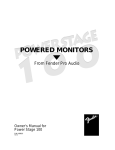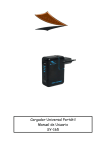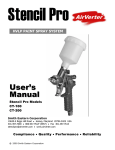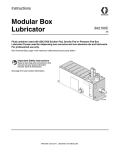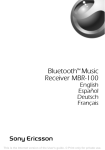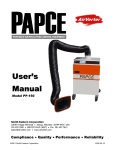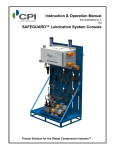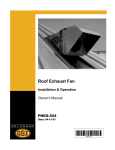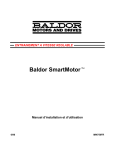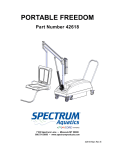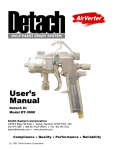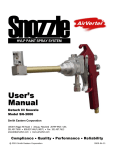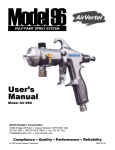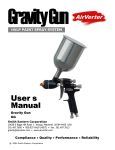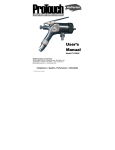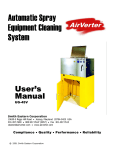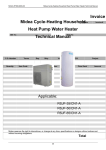Download User`s Manual - Offer Inspector
Transcript
PORTABLE AIR POLLUTION CONTROL EQUIPMENT User’s Manual Models PP-500 • PP-500XP U.S. Patents 6,143,048 6,264,711B1 Smith Eastern Corporation 10630-S Riggs Hill Road • Jessup, Maryland 20794-9425 USA 301.497.7600 • 800.937.HVLP (4857) • Fax 301.497.7613 [email protected] • www.airverter.com Compliance • Quality • Performance • Reliability ©2002 Smith Eastern Corporation 2007-12-11 AirVerter® Portable Air Pollution Control Equipment Please Read User's Manual BEFORE Using This Equipment WHEN IN THE PROXIMITY OF HAZARDOUS FUGITIVE EMISSIONS USE PROPER PERSONAL SAFETY EQUIPMENT INCLUDING RESPIRATOR, GOGGLES AND SAFETY CLOTHING. WARNING THIS EQUIPMENT IS OPERATED WITH HIGH VOLTAGE ELECTRICITY. ALWAYS TURN THE MACHINE "OFF" AND DISCONNECT POWER PRIOR TO MAINTENANCE OR REPAIR. WARRANTY Smith Eastern Corporation warrants to the Purchaser that Portable Air Pollution Control Equipment (PAPCE) is free from defects in material or workmanship under normal use and service for a period of twelve (12) months from the date of shipment. Should any failure appear during this period, Smith Eastern shall, if given prompt written notice by the Purchaser, correct such nonconformity by repair or replacement of the nonconforming part, F.O.B. Smith Eastern’s repair facility. Repair parts are warranted for ninety (90) days from the date of shipment, but repairs or replacements to original equipment shall not renew or extend the warranty period of such equipment. Equipment and parts furnished by Smith Eastern but manufactured by others shall be limited to the warranty offered by the manufacturer thereof. Smith Eastern reserves the right to limit this warranty in cases of misuse or abuse. Any modifications to equipment or recommended procedures will void the warranty. The foregoing warranty is exclusive and in lieu of other warranties of quality or performance, expressed, implied or statutory, including any warranties of merchantability or of fitness for a particular purpose. ABOUT PAPCE PAPCE is a California South Coast Air Quality Management District (SCAQMD) approved portable suction-type control device to capture fugitive vapor, mist, gases, fumes, odors, and other liquid and solid particulate matter from spraying, sanding, grinding, and welding operations. The adjustable filter arrangement allows maximum flexibility in the positioning of filters for optimum performance to suit a wide variety of applications. The articulating, self-supporting duct arms and tabletop downdraft containment system provide maximum flexibility in a portable particulate capture device. Closing dampers in the twin Flexible Ducts directs all suction through the tabletop containment system. Additionally all energy can be directed through one duct for maximum suction over a smaller containment area. When the tabletop system is not in use all suction is directed through the Flexible Ducts. USE PERSONAL SAFETY EQUIPMENT AROUND HAZARDOUS EMISSIONS 1 AirVerter® Portable Air Pollution Control Equipment UNCRATING, ARM INSTALLATION AND POWER SUPPLY VERIFICATION Uncrate unit being careful not to damage the casters, duct support arms and collection Hood. A. Verify all parts have been shipped and are not damaged 1. Ducts, Support Arms and Collection Hoods 2. Intake Filters (packaged in Table-top area) 3. Large Particulate Filter (Filter Compartment) 4. Pocket Filter (Filter Compartment) 5. HEPA Filter (Filter Compartment) 6. Carbon Filter (Filter Compartment) 7. Filter Frame B. Verify unit is correctly wired for your power supply. Unless otherwise specified at time of order, PAPCEs are wired for 440v 3-phase. C. Remove All Filters. D. The unit is shipped without a cord-cap or plug. This is the responsibility of the receiving party. Consult a qualified electrician to determine the correct cord-cap for your facility. Have a qualified electrician install the cord-cap. E. Plug in unit and switch on; verify motor turns clockwise when viewed from filter compartment. If motor does not turn clockwise wiring must be changed to conform to your power supply. Call 1-800-937-4857 if you need assistance. F. Remove wrappings from filters and install according to Filter Installation instructions below. G. Attach Support Arms and Ducts to the Swivel Mounts (see instructions on Attaching Swivel Mounts and Support Arms. FILTER INSTALLATION Filters should be installed as follows: A. For most applications, including painting, an Intake Filter should be attached to each Intake Hood (attached using the Velcro dots installed on the Hood). B. For welding applications, do not use Intake Filters. Intake Filters are made of polyester and could ignite. 2 C. Install filters in the filter compartment left to right as follows: 1. Carbon Filter (remove wrapping) 2. HEPA Filter 3. Pocket Filter 4. Large Particulate Filter (Pre-Filter) - The prefilter should be installed with the less dense side of the filter to the right and the more dense side of the filter to the left. USE PERSONAL SAFETY EQUIPMENT AROUND HAZARDOUS EMISSIONS AirVerter® Portable Air Pollution Control Equipment Figure 1 ATTACHING SWIVEL MOUNTS AND SUPPORT ARMS 1. For shipping the Swivel Bases are each in their own cardboard box with the mounting bolts enclosed in a plastic bag. 2. Securely mount the Swivel Base and Gasket using the hardware provided. The Swivel Base consists of two parts that allow the upper section of the swivel to move separately from the lower section. The Swivel Base has a rubber-band-style boot. The boot is used to slip over the groove between the upper and lower sections so air will not be drawn from the groove. The swivel should rotate freely after the arm and duct are installed. 3. The metal support structure for the arm is folded for shipment. Carefully unfold the structure and ensure it moves freely. Put the arm back in its folded position, as it will be easier to mount to the Swivel Base. CAUTION: Do not get fingers caught between arm support tubes. 4. There are (2) bolts, nuts, & (6) washers on the arm's Base Plate. Remove these components. These bolts are not tightened on the Base Plate for easy removal. SUPPORT ARM Center Plate Lower Support Structure Upper Support Structure Flexible Duct Base Plate Clamp Clamp Bolt Base Plate Here Swivel Base Rubber Boot Gasket Hood PAPCE Figure 2 USE PERSONAL SAFETY EQUIPMENT AROUND HAZARDOUS EMISSIONS 3 AirVerter® Portable Air Pollution Control Equipment ATTACHING SWIVEL MOUNTS AND SUPPORT ARMS (continued) 5. The Base Plate has multiple holes for many mounting configurations. You will use holes 1 & 8 for mounting the arm to the PAPCE. Bolt the Base Plate/arm to the swivel base using the hardware and holes 1 & 8. Tighten the hardware snugly. 1 8 Figure 3 6. Extend the arm out by pulling on the lower support structure. If the arm does not stay in place, slightly tighten the friction pivots located on the Base Plate and the Center Plate. These pivots use brown friction washers. There are (2) pivots located on the Base Plate and the Center Plate. Simply adjust the pivot points until the arm holds itself. Final pivot adjustment is to be done at the end of assembly. during use. Tighten the small screw on the damper lever so the damper will stay in its desired position, yet will move so the damper can be controlled. 9. The Hood has (2) pivot joints so the Hood can be moved up, down, left, and right, independent of the arm. The hardware that mounted the Hood to the Hood arm bar should be adjusted so the Hood can move side to side and hold its position 10. Final arm adjustment is based upon the arm holding itself in any position and not drifting. This will require the tightening or loosening of each of the pivot points located on the Base Plate, Center Plate, Hood arm bar, and Hood. The goal is to have the arm move as easily as possible and hold its position at the release point. The arm may need readjustment from time to time, dependent upon usage. 11. DO NOT OVER TIGHTEN THE FRICTION PIVOT JOINTS AS DAMAGE CAN OCCUR TO THE FRICTION WASHERS. IT IS ALWAYS BETTER TO TIGHTEN THE JOINTS A LITTLE AT A TIME TO GAIN THE DESIRED MOVEMENT. 7. Slide the Flexible Duct over the arm and attach the duct to the swivel base by using the clamp provided. DO NOT ALLOW THE FLEXIBLE DUCT TO GO OVER THE GROOVE OR THE RUBBER BOOT THAT COVERS THE GROOVE ON THE SWIVEL BASE. 8. Mount the Hood using the hardware supplied with the Hood. Please note how the hardware is positioned so the Hood will move easily and stay at that point. Your Hood has a built-in damper. Sometimes the damper blade can be loose and may tend to close 4 USE PERSONAL SAFETY EQUIPMENT AROUND HAZARDOUS EMISSIONS AirVerter® Portable Air Pollution Control Equipment OPERATION INTAKE HOODS Position Intake Hood(s) in close proximity to work area (ideally within 12-18 inches) for source capturing and extraction of welding smoke, dust, paint overspray and hazardous airborne fumes. Spraying Toward Filter Hoods Certain applications may prevent the operator from positioning the intakes within 12-18 inches of the work (such as aircraft wheel wells). In these cases position the Hoods to create the best possible airflow. Ensure dampers are fully opened for maximum efficiency. The Intake Filters (PP-016) are flammable. Remove the Intake Filters (PP-016) from Hood(s) before using for welding fume extraction. Welding Fumes Extraction TABLETOP When using the tabletop downdraft system, ensure the duct dampers are fully closed for maximum suction through the tabletop unit. Position small parts so that the operator will be painting toward the tabletop. Spraying On The Tabletop USE PERSONAL SAFETY EQUIPMENT AROUND HAZARDOUS EMISSIONS 5 AirVerter® Portable Air Pollution Control Equipment FILTER EFFICIENCY 1. The Magnehelic Gauge allows the operator to monitor filter efficiency by measuring the pressure differential across the filters. a. Readings of twice the amount recorded when filters are new indicate clogged filters. For instance, if the Magnehelic Gauge reads 2 when the filters are new, a reading of 4 would indicate the filters should be replaced for optimum performance. b. The Magnehelic Gauge should be "zeroed" if required with zero adjustment screw in the front of the gauge (plastic cover should not be removed). c. As the Intake Filters (PP-016) are outside the area measured by the Magnehelic Gauge, these filters should be changed frequently, depending on the volume of paint sprayed. BLOWER OPERATION 1. The distance between the Blower and Inlet Cone is critical to effective and safe operation of the PAPCE unit. The unit is adjusted at the factory to the proper distance. 2. The user should periodically inspect the unit to ensure the Blower remains firmly attached to the Motor shaft and has not shifted its position on the shaft. Blower Blower Wheel Back Plate Uniform Clearance Motor "A" Dimension (See Table) Inlet Cone Wheel-to-Inlet Cone Clearances 6 Blower Wheel Size "A" Dimension 16 2.30 in. USE PERSONAL SAFETY EQUIPMENT AROUND HAZARDOUS EMISSIONS AirVerter® Portable Air Pollution Control Equipment ILLUSTRATED PARTS BREAKDOWN SUPPORT ARM AND FLEXIBLE DUCT (Models PP-500 and PP-500XP) PP-025-10 10 Ft. X 7 In. Support Arm With Flexible Duct and Hood USE PERSONAL SAFETY EQUIPMENT AROUND HAZARDOUS EMISSIONS 7 AirVerter® Portable Air Pollution Control Equipment ILLUSTRATED PARTS BREAKDOWN PP-500 8 USE PERSONAL SAFETY EQUIPMENT AROUND HAZARDOUS EMISSIONS AirVerter® Portable Air Pollution Control Equipment ILLUSTRATED PARTS BREAKDOWN PP-500XP USE PERSONAL SAFETY EQUIPMENT AROUND HAZARDOUS EMISSIONS 9 AirVerter® Portable Air Pollution Control Equipment COMPONENTS INTAKE AND LARGE PARTICULATE FILTERS (PRE-FILTERS) The Large Particulate Filter media is 100% polyester. The dual-stage, layered media has a less dense layer on the air-entering side and a denser layer on the air-leaving side. This density pattern prevents face loading as larger particles are trapped in the front layer and smaller particles in the back layer. Applications include: 1. Paint Overspray 2. Sanding Dust 3. Oil Mist 4. Adhesive Overspray Construction and Performance Data Media Size 24" x 24" x 1" Media 100% Polyester Resistance @ 400 FPM .20″ W.G. Paint Holding Capacity 2.7 lbs. Per Sq. Ft. POCKET FILTERS Construction: The Pocket Filters are made from two layers of 100% polyester fibers. • The first layer of the dual-layer media is constructed of a blend of small denier fibers, tightly needled to achieve high efficiency. A heavy tack on the air leaving side holds particulates in the filter to prevent them from blowing downstream. • The second layer is constructed of a saturated bond web utilizing a halogenfree binder system tightly needled to achieve high efficiency. • Polyester media is moisture resistant. It is not affected by humidity - up to 100%, or sensible moisture. The pockets are completely self-supporting in a V-shape configuration. Self-Sealing Design: The pockets are sewn to 10-gauge wire internal support frames with the media extending beyond the frames to form a built-in gasket. Long Service Life: The dual-layer media design in a multi-pocket configuration results in very high particulate holding capacity for long service life. The filters are ideal for difficult operating conditions, such as turbulent air flow or heavy dirt loading. Construction and Performance Data 10 Media Size 24" x 24" x 6" Media Dual Layer 100% Polyester Resistance @ 400 FPM .83″ W.G. USE PERSONAL SAFETY EQUIPMENT AROUND HAZARDOUS EMISSIONS AirVerter® Portable Air Pollution Control Equipment HEPA FILTER HEPA filters used in these units are designed for use where higher airflow velocities occur offering the user a wide range of advantages, including: same amount of space, as do standard HEPA filters. This was accomplished through the use of a specially designed separator to allow up to 65% more media to be installed in a 24" x 24" x 11-1/2" area. • Higher air flow with no increase in resistance. • Higher velocities deliver up to 500 FPM while maintaining the highest efficiencies. The result for the user is a filter that lasts longer and will operate at a higher capacity than typical HEPA filters. The filter has only .72" W.G. resistance at 1100 CFM, compared to 1.0" W.G. of standard HEPA filters. The filter has more media area in the . Performance Data DIMENSIONS HxWxD 24 x 24 x 11-1/2 99.97% @ .3 Micron CAPACITY (CFM) @ Initial Pressure Drop 1.0" 1.35" 1500 2000 ACTIVATED CARBON FILTER Carbon Filters are designed for odor removal only. They are not for particulate collection. Odor removal is a direct function of the amount of carbon exposed to the air stream. Carbon filters are designed for light to moderate odor conditions in multi-stage filtration systems where other filters are installed upstream from the carbon filters. The Activated Carbon Filter has 1 1/3 pounds of carbon per square foot in a 2" thick pad (600 grams per sq. ft. of filter face area). Each filter is sealed to prevent adsorption from occurring prior to installation. Other filters are necessary to remove particulate contaminants from the air to prevent coating the microscopic carbon pore structure. Performance Data - 2" Filter Based on ASHRAE Standard 52.1-1992. Tolerances conform to ARI Standard 850.84 Recommended Final Resistance Activity Rating UL Classification Recommended Temperature Limit 1.2" W.G. Minimum 60% on carbon tetrachloride at 251C. UL Class 2 According to UL Standard 900 120 F (491 C). USE PERSONAL SAFETY EQUIPMENT AROUND HAZARDOUS EMISSIONS 11 AirVerter® Portable Air Pollution Control Equipment DYWER MAGNEHELIC GAUGE (Used in All Models) CATALOG DATA Range, Inches of Water: Minor Divisions: Ambient temperature range: Rated total pressure: .20 20° to 140° F. -20" Hg. to 15 psig.+ Overpressure: Relief plug opens at approximately 25 psig. Connections: 1/8" NPT female high and low pressure taps duplicated - one pair side and one pair back. Accuracy: Weight: 12 0-8.0 Plus or minus 2% of full scale (3% on - 0 and 4% on - 00 ranges), throughout range at 70°F. 1 lb. 2 oz. USE PERSONAL SAFETY EQUIPMENT AROUND HAZARDOUS EMISSIONS AirVerter® Portable Air Pollution Control Equipment BALDOR 5 HP ELECTRIC MOTOR (Used in Model PP-500) CATALOG DATA VM3613T 5 3450 184TC 3628M CATALOG ITEM: HORSEPOWER: RPM: NEMA FRAME: TYPE: "C" DIMENSION: EFF @ FULL LOAD: VOLT CODE: SHIPPING WEIGHT: MULTIPLIER SYM: 16.56 85.5 E 98 L1 MOTOR DATA VOLTAGE: FULL LOAD AMPS: PHASE: HERTZ: POLES: CODE: DESIGN: SERVICE FACTOR: 208-230/460 13.2-12/6 3 60 02 02 B 1.15 ENCLOSURE: MOUNTING: BASE: D.E. BEARING: O.D.E. BEARING: ROTATION: SPEC NUMBER: RATING: RATING - NOMINALS Rated Output Volts Full Load Amps Speed Hertz Phase NEMA Design Code LR KVA Code Efficiency Power Factor Service Factor Rating - Duty TEFC F1 N 6206 6205 R 36A03X100 40C CHARACTERISTICS 5 HP 208-230/460 13.2-12/6 3450 60 3 B K 87.5 92 1.15 40C AMB-CONT Break Down Torque Locked-Rotor Torque Starting Current No-Load Current Line-line Resistance @ 25 Degrees C Temperature Rise, in degrees C @ FL 32 27 56 1.8 2.4 N/A LOAD CHARACTERISTICS - TESTED % of Rated Load Power Factor Efficiency Speed (rpm) Line Amperes 25 64 82.7 3565 2.3 50 83 87.8 3533 3.3 75 89 88.4 3498 4.6 100 92 87.8 3462 5.9 125 93 86.5 3421 7.3 150 94 84.7 3378 8.9 S.F. 93 87 3437 6.7 USE PERSONAL SAFETY EQUIPMENT AROUND HAZARDOUS EMISSIONS 13 AirVerter® Portable Air Pollution Control Equipment BALDOR 5 HP EXPLOSION PROOF ELECTRIC MOTOR (Used in Model PP-500XP) CATALOG DATA CATALOG ITEM: HORSEPOWER: RPM: NEMA FRAME: TYPE: VM7072T 5 3450 184TC X3628M "C" DIMENSION: EFF @ FULL LOAD: VOLT CODE: SHIPPING WEIGHT: MULTIPLIER SYM: 18.87 85.5 E 98 L1 MOTOR DATA VOLTAGE: FULL LOAD AMPS: PHASE: HERTZ: POLES: CODE: DESIGN: SERVICE FACTOR: 208-230/460 13.2-12/6 3 60 02 02 B 1.00 RATING - NOMINALS Rated Output Volts Full Load Amps Speed Hertz Phase NEMA Design Code LR KVA Code Efficiency Power Factor Service Factor Rating - Duty ENCLOSURE: MOUNTING: BASE: D.E. BEARING: O.D.E. BEARING: ROTATION: SPEC NUMBER: RATING: XPFC F1 N 6206 6205 R 36E396X100 40C CHARACTERISTICS 5 208-230/460 13.2-12/6 3450 60 3 B Break Down Torque Locked-Rotor Torque Starting Current No-Load Current Line-line Resistance @ 25 Degrees C Temperature Rise, in Degrees C @ FL 29 22 47 1.4 2.86 N/A K 85.5 93 1.15 40C AMB-CONT LOAD CHARACTERISTICS - TESTED % of Rated Load Power Factor Efficiency Speed (rpm) Line Amperes 14 25 75 80.2 3555 2.1 50 88 85.8 3517 3.2 75 93 86.5 3475 4.5 100 94 85.7 3431 5.8 125 95 84.3 3386 7.2 150 95 82.2 3332 8.7 S.F. 95 84.9 3404 6.8 USE PERSONAL SAFETY EQUIPMENT AROUND HAZARDOUS EMISSIONS AirVerter® Portable Air Pollution Control Equipment CROUSE-HINDS MANUAL LINE STARTER AND ENCLOSURE (Used in Model PP-500XP) Cl. I, Div. 1 & 2 Groups C,D Cl. II, Div. 1, Groups E,F,G Cl. II, Div. 2, Group F,G Cl. III Explosion Proof Dust-Ignition Proof Raintight Wet Locations NEMA 3,7CD,9EFG,l2 FEATURES • Operating Handle may be padlocked in either "ON" or "OFF" positions • Bodies have bottom drilled and tapped entrances for power conduits plus one at the top for control conduit. CERTIFICATIONS & COMPLIANCES • • • • • • • NEC/CEC: Class I, Division 1 & 2; Groups C,D Class II, Division 1; Groups E,F,G Class II, Division 2; Groups F,G Class III UL Standards UL 698 UL Subject 2062 - High AIC rating (interrupting Capacity) • • • • • • Volt 240 480 600 • • • • RMS Symm-Amperes 65,000 50,000 25,000 CSA Standard: C22.2 No. 14 NEMA/EEMAC: 3, 7CD, 9EFG, 12 STANDARD MATERIALS • • Body and covers and toggle operator copper-free aluminum Operating shaft - stainless steel • • Cover bolts, washer and retractile springs stainless steel Interior parts - sheet steel, electrogalvanized *National Electrical Code is a Registered Trademark of the National Fire Protection Association. USE PERSONAL SAFETY EQUIPMENT AROUND HAZARDOUS EMISSIONS 15 AirVerter® Portable Air Pollution Control Equipment TROUBLESHOOTING Problem Unit Fails To Start Unit Stops Running No/Low Air Flow Loud Clanking Noises 16 Probable Cause Remedy 1. Improper Power Connection 1. Ensure Motor Starter Wired For Correct Current 2. Breaker Tripped 2. Reset Breaker 3. Improper/Faulty Electrical Connection 3. Repair/Replace Electrical Connections. 1. Incorrect Power Supply 1. Ensure Unit Connected To Correct Power Supply 2. Overload Relay Heaters Failed 2. Replace Overload Relay Heaters 3. Breaker Tripped 3. Reset Breaker 1. Blower Rotating In Wrong Direction 1. Ensure Unit Is Wired Correctly For Clockwise Rotation 2. Filter Clogged 2. Replace Clogged Filter 3. Ducts Blocked 3. Remove Blockage 1. Object Obstructing Rotation Of Blower 1. Remove Object To Allow Blower To Rotate Freely 2. Blower Misaligned 2. Adjust Blower To Proper Position On Motor Shaft USE PERSONAL SAFETY EQUIPMENT AROUND HAZARDOUS EMISSIONS




















